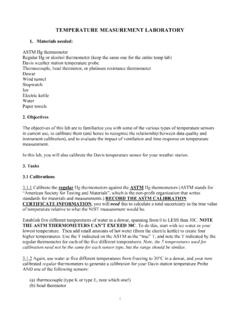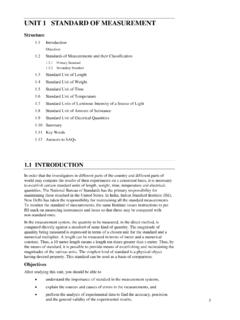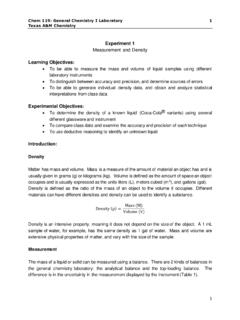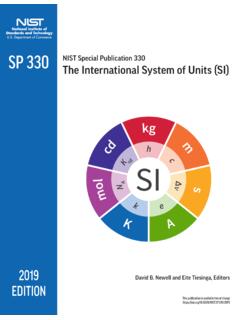Transcription of Turbidity measurement - WHO
1 Fact Sheet Turbidity measurement The importance of measuring Turbidity Turbidity is the amount of cloudiness in the water. This can vary from a river full of mud and silt where it would be impossible to see through the water (high Turbidity ), to a spring water which appears to be completely clear (low turbid- ity). Turbidity can be caused by : silt, sand and mud ;. bacteria and other germs ;. chemical precipitates. It is very important to measure the Turbidity of domestic water supplies, as these supplies often undergo some type of water treatment which can be affected by Turbidity . For example, during the rainy season when mud and silt are washed into rivers and streams, high Turbidity can quickly block filters and stop them from workingeffectively.
2 High Turbidity will also fill tanks and pipes with mud and silt, and can damage valves and taps. Where chlorination of water is practised, even quite low Turbidity will prevent the chlorine killing the germs in the water efficiently. Some treatment systems, such as sedimentors, coagulators and gravel prefilters are designed to remove Turbidity . It is important for operators of both large and small treatment systems to know how well these systems are working. Measuring the Turbidity of the water before and after each part of the system can tell the operator where maintenance or cleaning is needed. Measuring Turbidity Turbidity can be measured using either an electronic Turbidity meter or a Turbidity tube.
3 Both methods have advantages and disadvantages, as shown below. Turbidity is usually measured in nephelometric Turbidity units (NTU) or Jackson Turbidity units (JTLJ), depending on the method used for measurement . The two units are roughly equal. Fact Sheet Turbidity meter There are many different types of electronic Turbidity meter available. Their advantages and disadvantages are as follows : Advantages very accurate, and especially useful for measuring very low turbidities (less than 5. TU). Disadvantages high cost need power supply (mains or battery). easily damaged It is impossible to give general guidelines on their use should refer to manufacturers' instructions for use and maintenance of these meters.
4 Figure 1. shows an example of an electronic Turbidity meter. Figure 1. Turbidity meter Fact Sheet Turbidity tube The advantages and disadvantages of the Turbidity tube are as follows : Advantages simple design low cost not easily damaged Disadvantages cannot measure very low turbidities (usual minimum is 5. TU). less precise Since the Turbidity tube is simple to use, instructions are given below. It is, however, recommended that you refer to the instructions provided with the tube that you are Turbidity tube is shown in Figure 2. Figure 2. A Turbidity tube To measure the Turbidity of a water sample using a Turbidity tube : Where the tube is in two parts, push the two parts together; making sure that they fit squarely.
5 Take a sample of water from the water source.. Hold the tube in one hand near the bottom and look into the open end with your head about 10 to 20 centimetres above the tube, so that you can clearly see the black circle, Fact Sheet cross or other murk on the bottom of the tube. Slowly pour the water sample into the tube, waiting for air bubbles to rise if necessary, until the mark on the bottom of the tube just disappears. Stop pouring the water sample into the tube and look at the level of water in the tube. For Turbidity tubes which have a Turbidity scale marked on the side, read the number on the nearest line to the water level. This is the Turbidity o f the water.
6 I f the tube does not have a scale marked, measure the distance from the bottonz o f the tube to the water level with a tape measure and look up or calculate the Turbidity o f the water sample using the instructions provided with the tube. After use, wash the tube in clean water and store the two parts of the tube where they cannot be damaged. Turbidity guidelines for drinking water For drinking water supplies, the following guidelines should be taken into consideration : Drinking water should have a Turbidity of 5 NTU/JTU or less. Turbidity of more than 5 NTU/JTU would be noticed by users and may cause rejection of the supply. Where water is chlorinated, Turbidity should be less than 5 NTU/JTU and preferably less than 1 NTU/JTU for chlorination to be effective.



















